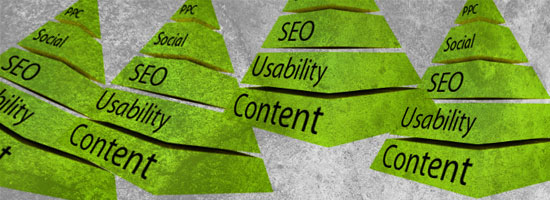- Home
- Blog
- Web Design The Web Strategy Pyramid: A Well-Balanced Web Strategy
The Web Strategy Pyramid: A Well-Balanced Web Strategy
-
 7 min. read
7 min. read
-
 William Craig
William Craig CEO & Co-Founder
CEO & Co-Founder
- President of WebFX. Bill has over 25 years of experience in the Internet marketing industry specializing in SEO, UX, information architecture, marketing automation and more. William’s background in scientific computing and education from Shippensburg and MIT provided the foundation for MarketingCloudFX and other key research and development projects at WebFX.
 Remember when mom always told you to eat your vegetables? Little did you know she was giving you fantastic advice for managing your Web strategy. In these days of Twitter, Facebook, forums, blogs and more, it can be tempting to skip over the basics and dive headfirst into an oh-so-tempting dish of social media or SEO “tricks.” Businesses of all sizes are pigging out on social media without putting an equal amount of effort into forging a solid foundation built on a user-friendly Web experience and great content.
Remember when mom always told you to eat your vegetables? Little did you know she was giving you fantastic advice for managing your Web strategy. In these days of Twitter, Facebook, forums, blogs and more, it can be tempting to skip over the basics and dive headfirst into an oh-so-tempting dish of social media or SEO “tricks.” Businesses of all sizes are pigging out on social media without putting an equal amount of effort into forging a solid foundation built on a user-friendly Web experience and great content.
To deliver a site that gives users the experience they are looking for, we need to set it upon a solid foundation of content, usable navigation, and strong SEO practices. With this in mind, let’s take a look at what I call the “The Web Strategy Pyramid” (a tip of the hat to the FDA’s Food Pyramid for the inspiration).
The Web Strategy Pyramid

Content
Let’s start at the bottom of the pyramid and work our way up. “Content is king,” is a cliché, but it’s that way for one reason: it’s true.
You can have the best ads, the most Twitter followers, and the coolest design, but none of it will stick with your users and gain momentum if you don’t have the content they are looking for. Fantastic content is the fuel that drives all these other efforts. After all, why would anyone tweet about your site or click that Facebook Like button if you don’t have anything worth sharing?
The single best way to get a great start is with your content. If it’s unique, compelling, interesting and written for your users, you’ve given yourself a fantastic foundation to build on. A few points to consider before we move on:
- Does your site content use terms that your users understand or are you using jargon?
- Is the content intentionally written for the Web in short, digestible chunks, or is it recycled from a corporate brochure?
- If you’re a blogger, does your content have a unique perspective and point of view that’s worthy of discussion and retweets?
Creating fantastic Web content is a complex subject that if you’re interested in learning a bit about, you can read up on via the Content Strategy category.
Usability/Design
If your visitors can’t find what they’re looking for, it won’t matter that you’ve filled your site with fantastic content. Complex navigation, poor use of whitespace, distracting graphics or animations, and a vast array of other UX missteps can destroy your hope of converting a visit into a sale, or a follower into a raving fan. Not long ago, performing a usability test on a complex site or application could cost tens of thousands of dollars.
Now, there are many alternatives for gathering user feedback on your site design and interface. Simple “discount” testing with co-workers or family members using paper mockups or wireframes. Can they perform the most common tasks?
Do they understand your navigation? A basic lab setup using a tool like Adobe Connect to capture the user’s screen movements, vocal comments, and facial expressions, all of which can be recorded and archived for review and analysis. Online survey tools like Zoomerang or Survey Monkey combined with screenshots can be a quick way to gather input from key audiences.
Usability tools like Usabilla can help you gather more specific interface feedback through a combination of survey questions and heat maps. Those of you who are veterans of usability testing will agree that none of these compare to having a Ph.D. conduct an interview/test in a lab setting. However, my point is this: Lack of budget is no longer an excuse for skipping usability testing and review.
Some basic tools and well thought-out questions are far better than not testing at all. Taking this step will put you light years ahead of many competitors.
SEO
Some of you may be surprised that SEO is not one of the items at the base of the pyramid. If they can’t find you, who cares?
Well, let me explain: If your content is well written and focused on the needs of your users, you’ll already have made good progress down the road to effective SEO. Too many times people try to find the “secret” to ranking well in the search engines, but never take the time to evaluate the content on their site. One of the real secrets to SEO is building a solid base of relevant content.
Again, here are a few points to consider:
- Do you use the keywords in your content that your users are searching for? There are a multitude of tools to help you research this including Google Insights, Wordtracker and others.
- Do your headings (i.e. H1, H2, H3) include keywords?
- Do your page titles contain keywords and reflect the topic of the content?
Is your site content written to make users happy, or search engines happy? I hope that it’s the former.
Social Media
Ah, finally. On to the good stuff!
Now that you’ve forced your way through establishing a rock-solid foundation of content, usability, and SEO, we’re ready to dive head first into social media. I’ll assume that everyone reading this is already aware of the sites like Facebook, Twitter, and MySpace and probably has some experience using tools to optimize their social media efforts (Radian6, ScoutLabs, HootSuite, etc.) With this assumption in mind, the single most important point I can make is this: Have a long-term strategy for social media. Far too many companies and individuals launch a Facebook page or social media effort without having a target audience, clear purpose, and well-defined goals. Do you have a well-defined strategy for social media?
Here are a few items to help you determine if that’s the case:
- If you’re a corporation and someone is assigned to monitoring social media, is it their sole focus, or is it something they only do when they have spare time?
- Does your company use a PR or advertising agency for social media? Using these types of firms is typically great for the initial launch and ongoing campaigns, but what happens in two years? Four years?
- Who responds to your customers concerns on Twitter, Facebook, and forums? Will that choice stand the test of time and customer expectations? More importantly, is it cost effective?
Pay-per-click (PPC)
Now that we’ve established a website strategy forged upon great content, a user-friendly interface, SEO, and Social Media, let’s top things off with a bit of PPC. Depending on your business needs, PPC could play a fairly major role. In most typical cases, however, you’ll be best served by taking care of all the other essentials before using PPC.
Look at it this way: Why would you spend money driving visitors to a site that is not well-positioned to make the most of every one of those visits?
A Few Final Thoughts
Will this pyramid potentially shift based on your specific needs? Certainly. If you’re a small/medium business selling a complex product to a small niche market, SEO and PPC may be more important for you.
If you’re a blogger, social media may be a vital part of your foundation. This isn’t chiseled in stone, but the core point remains the same regardless of your goals: take care of the basics and don’t let that tempting piece of “dessert” divert your attention until you’ve taken care of the basics. Your users (and possibly your bank account) will thank you for it.
Related Content
-
 President of WebFX. Bill has over 25 years of experience in the Internet marketing industry specializing in SEO, UX, information architecture, marketing automation and more. William’s background in scientific computing and education from Shippensburg and MIT provided the foundation for MarketingCloudFX and other key research and development projects at WebFX.
President of WebFX. Bill has over 25 years of experience in the Internet marketing industry specializing in SEO, UX, information architecture, marketing automation and more. William’s background in scientific computing and education from Shippensburg and MIT provided the foundation for MarketingCloudFX and other key research and development projects at WebFX. -

WebFX is a full-service marketing agency with 1,100+ client reviews and a 4.9-star rating on Clutch! Find out how our expert team and revenue-accelerating tech can drive results for you! Learn more
Make estimating web design costs easy
Website design costs can be tricky to nail down. Get an instant estimate for a custom web design with our free website design cost calculator!
Try Our Free Web Design Cost Calculator


Web Design Calculator
Use our free tool to get a free, instant quote in under 60 seconds.
View Web Design CalculatorMake estimating web design costs easy
Website design costs can be tricky to nail down. Get an instant estimate for a custom web design with our free website design cost calculator!
Try Our Free Web Design Cost Calculator




